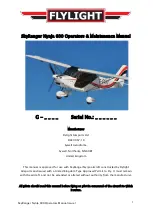
P-40 Tomahawk manual
This manual probably accompanied the AVG Tomahawks to Rangoon. It was
published by the British Air Ministry, and the title page says "Tomahawk
I". However, internal evidence (the engine designation and references to
the Royal Air Force blocks from which the China-bound Tomahawks were
taken) tie it to the Tomahawk IIBs sent to Burma for the AVG. On the other
hand, there is also some internal evidence (i.e., references to French
instrumentation) that the text was not brought entirely up to date, and
that some paragraphs may apply to the Tomahawk I or IIA models.
I copied the manual in 1989 at the National Air & Space Museum, which in
turn had copied it and other material from Larry Pistole's large
collection of AVG memorabilia. Pistole's collection was later acquired by
the Flying Tigers Association, and NASM's copies somehow went missing, so
this is the only version known to be accessible.
I follow the original as exactly as possible, including spelling and
typography. Words in brackets [like this] have been added. Comments
beginning DF: are by the webmaster; those beginning ES: are by Erik
Shilling, a pilot with the AVG, who read the manual with an eye to
comparing it with his memory of the AVG Tomahawks. Erik's comments (with
other information) seem to suggest that the planes sent to China may have
had components of older aircraft installed, possibly so Curtiss could use
up its inventory of parts, and that the planes were actually closer to IIA
models than the IIBs shown in Curtiss records. --
FOR OFFICIAL USE ONLY
AIR PUBLICATION 2013A
Pilot's Notes
PILOT'S NOTES
TOMAHAWK I
ALLISON V-1710-C15 ENGINE
INTRODUCTION
1. The Tomahawk I is a single-seater, low wing, monoplane with retractable
landing gear and enclosed cockpit, powered with an Allison V-1710-C15
engine, which drives a Curtiss multi-position, constant speed,
electrically operated, tractor propeller. The following are the main
dimensions:
Span 37 ft., 3 1/2 in., Overall length 31 ft. 8-9/16 in.
Overall height with tail down 9 ft., 7 in.
2. The cockpit is totally enclosed. The windscreen is in three sections of
laminated glass and behind the windscreen there is a section of 1-1/2 inch
glass for protection from gunfire. The transparent cabin cover slides fore
and after for entry and exit purposes. An emergency release is provided by
which the entire sliding section has an emergency exit on the port side,
for us in event of turnover. The structure behind the pilot is of
sufficient strength to withstand a turnover landing. Three pieces of armor
plate are provided; one piece 7 mm. thick ahead of the pilot from the
windscreen line down to the top of the engine, a piece 7 mm. thick behind
the pilot's back, and 9 mm. thick behind his head.
3. The main plane is a cantilever multi-spar, skin stressed type built in
two pieces and joined at the centerline of the airplane. The wing tips are
detachable. The joint where the two wing sections are connected will serve
as a skid in case of an emergency landing with the wheels retracted.
The ailerons are both dynamically and aerodynamically balanced. They are
operated by the conventional stick control. A fix type trimming tab,
adjustable in the ground is provided on 4x 4 Šeach aileron. The
Summary of Contents for P-40 Tomahawk
Page 21: ......

































